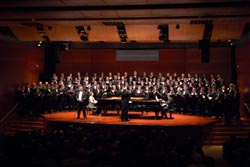Center Stage

- NEW YORK, NY-The Museum of Jewish Heritage in Battery Park is New York's primary institution of public education about modern Jewish history and the Holocaust. By weaving together personal experiences and world events, the museum tells the story of 20th century Jewish life from the perspective of those who lived it.
The 375-seat Safra Hall at the Museum of Jewish Heritage installed a NEXO Geo S Tangent Array and NEXO PS10 and PS8 monitor system. Pictured here: Sept 27, 2006, the world premiere of the two-piano version of the first movement of Dmitri Shostakovich's Symphony No. 13, based on Yevtushenko's poem. Artists are: pianists, Misha and Cipa Dichter; bass soloist, Valentin Peytchinov; and a male chorus led by Patrick Gardner.
The Museum's Robert M. Morgenthau Wing offers views of the Statue of Liberty and Ellis Island. The first new construction project to begin in Lower Manhattan after September 11, 2001, the Morgenthau Wing was completed in September 2003. Spaces include a 5,000 square-foot event space, an outdoor terrace with adjacent indoor space, classrooms with multi-media facilities, and the 375-seat Edmond J. Safra Hall.
The work of acoustic designer Peter George, Safra Hall is the museum's premier performance space for public programs. Though careful thought went into the architectural and acoustic design of the hall, less attention was given to the needs for amplified performances and presentations. A ceiling-mounted loudspeaker system carried the burden of speech reinforcement for lecture/presentations.
"For any public program that required much more than sound for one speaker," said the Museum's technical manager, Matt Szwed, "the museum had to rent a sound system." In addition to its own events, the museum books the hall to corporate clients such as Forbes, IBM, Time-Warner, and for use by the Tribeca Film Festival. And for most of those events, obstruction of sightlines (especially for film) was an issue when a rental system was brought in.
Sightline obstructions-as well as aesthetic considerations-were not a problem when the museum rented the NEXO GEO S array. By early 2005, the museum was renting a NEXO rig from Viper Studios, and in the summer of that year, demo'd a system for a month.
The museum realized the need for a permanent solution that would match the hall's sound technology to the level of its acoustics and aesthetics. Over one month in late Summer 2006, Viper Studios' Charles Moses and systems tech Art Williams, along with Szwed, installed a main house system consisting of two clusters of four GEO S 805s, one GEO S 830, and one NEXO CD12 subwoofer per side. The installation also included a stage monitoring system of four NEXO PS8s and PS10s; two PS8s have dual functions as either front fills or additional monitors.
"The idea was to have a permanent system that was elegant and discrete in design and appearance," said Szwed, "that would offer the best in sound quality and eliminate any sightline issues." Moses and Viper's acoustical engineer, Burton Ishmael, EASE-modeled the hall and found that, "NEXO GEO S was the correct speaker solution to compliment that room," said Moses. Using NEXO GEOSoft2 software confirmed their Ease findings.
"Before our acoustical analysis," said Moses, "we knew that the arrays, five cabinets per side, needed to be as tight to the ceiling as possible to reduce any sightline issues and, more than that, making them virtually unnoticeable. The system produces even SPL from the front row seats to the rear of the house. The podium microphones are in close proximity to the house right stack without headroom gain being sacrificed. Also, the GEO S arrays are extremely quiet onstage making it the perfect sound solution for such an intimate performance space. The PS10 and PS8 stage monitors are extremely low profile, clean and natural sounding. Performing artists are fascinated by the sound quality they experience onstage."
A daily selection of the top stories for AV integrators, resellers and consultants. Sign up below.
The NEXO arrays are supported by two NX242TD GEO S processors, and the monitors by two NEXO PS10TD and PS8TD processors. Two Camco 3Q 4-channel amplifiers and two Camco Vortex 6.0 amplifiers drive the systems. Viper also installed a custom Whirlwind 32x8 stage box with monitor and FOH tails, and a complete Sennheiser wireless mic system.
The AVNetwork staff are storytellers focused on the professional audiovisual and technology industry. Their mission is to keep readers up-to-date on the latest AV/IT industry and product news, emerging trends, and inspiring installations.
